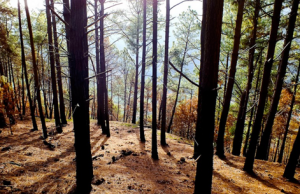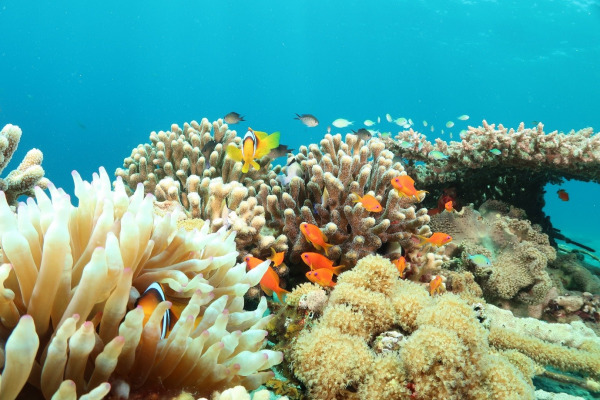Dr. Tamir Klein Sees the Forest and the Trees

While studying trees during his postdoctoral fellowship, Dr. Tamir Klein made such a startling discovery that his research supervisor at the University of Basel at first declared that the finding must have been a mistake. In the forest, trees are known to compete for resources such as light and nutrients, but Klein found that the same trees also engage in sharing: He showed that carbon molecules taken up by the canopies of mature spruce trees were passed through the soil in surprisingly large quantities to neighboring beech, larch and pine. As he reported in Science in 2016, the carbon was being transferred via “underground highways” formed by overlapping networks of root fungi.
“Neighboring trees interact with one another in complex ways,” says Klein. “Of course, there is a great deal of competition among them, but they also form communities, sorts of ‘guilds,’ within which individual trees share valuable resources. In fact, trees belonging to a ‘guild’ usually do much better than those that don’t.”
Israel’s advantage: how trees adapt to drought
In his new lab in the Weizmann Institute’s Plant and Environmental Sciences Department, Klein follows up on these findings to investigate tree ecophysiology: how the tree functions in its ecosystem. “Studies on ‘underground’ tree collaboration may reveal which tree species get along well, and this may help determine which trees should be planted next to one another,” he says. “Our studies have additional relevance to forestry and agriculture because we elaborate on the mechanisms of growth and drought resistance of different tree species.”

Only five percent of Israel’s land is covered by forest, but the country nonetheless offers unique advantages for forest research: Its hot, dry climate provides an excellent opportunity for investigating how trees adapt to drought and stress. Many trees common to Israel are already resistant to drought; understanding the mechanisms that allow them to live with little rain may help develop varieties of lemons, almonds, olives and other tree crops that can grow in even drier areas.
Projects in Klein’s lab aim to clarify how trees manage their water and carbon budgets – both separately and as a forest community. In one study the team focuses on emboli: tiny air bubbles that form inside the tree’s water channels during drought. When drought persists, the emboli can kill a tree, much like blood vessel clots that can cause a fatal heart attack in a human being. After injecting fluids into tree branches at different pressures, Klein and his students analyze the emboli in the minutest detail, using micro-computed tomography.
In Weizmann’s greenhouses Klein’s team members experiment with seedlings of pine, cypress, carob and other trees commonly found in Israel. The researchers make use of advanced technologies, including innovative nuclear magnetic resonance imaging, to study hydraulic conductivity in trees and a special lamp-equipped belowground camera to study the growth of tree roots in the soil.
When conducting field studies on their research plot near Beit Shemesh, Klein and his students hug trees – not to have a spiritual experience, but to follow a tree’s growth by encircling the trunk with a measuring tape. In parallel they apply laser isotope analysis and analytical chemistry techniques to trace carbon metabolism in individual trees, and they investigate carbon transfer among trees via different types of fungal “highways.” The scientists also employ thermal imaging, which enables remote temperature measurements, to study the rate of evaporation in the foliage.

These studies will help predict how future climate changes, including global warming and the rise in greenhouse gases, may affect forests. In one set of experiments, for example, Klein will double the concentration of CO2 to mimic the atmospheric conditions that may emerge on Earth as a result of pollution. Klein hasn’t owned a car in ten years, so as not to contribute to CO2 emissions, but he warns against jumping to conclusions when it comes to the impact of increased CO2 on tree biology. “Higher CO2 concentrations don’t help trees grow faster – contrary to the hopes of industrialists – but surprisingly, recent research suggests they might render the trees more resistant to drought-induced stress. This doesn’t mean it’s OK to carry on with CO2 pollution, but it does mean that we need to deepen our understanding of its effects on trees in general and on agricultural tree crops in particular.”
Surrounded by pines
Growing up in Nazareth Illit, in a house surrounded by pine forest, Tamir Klein spent a great deal of time in nature. He went to hiking camps as a youth and today holds a certificate to be a nature tour guide. Klein earned his BSc with honors in biochemistry at the Hebrew University’s Faculty of Agriculture and his MSc and PhD degrees from the Weizmann Institute. After completing postdoctoral studies at the University of Basel, he conducted research at the Agricultural Research Organization – Volcani Center in Beit Dagan before joining the Weizmann faculty in 2016. He lives in Rehovot and has two sons, ages six and two and a half.
Dr. Tamir Klein’s research is supported by Nella and Leon Y. Benoziyo; and Norman Reiser. Dr. Klein is the incumbent of the Edith and Nathan Goldenberg Career Development Chair.




